2019 PLMA Member Resources Directory
November 2019
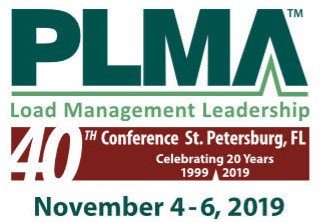
Over 320 people attended PLMA's 40thConference in St. Petersburg.
CLICK HERE to view the presentations and photos from this event.
Source: PLMA
Type: Presentations and Photos
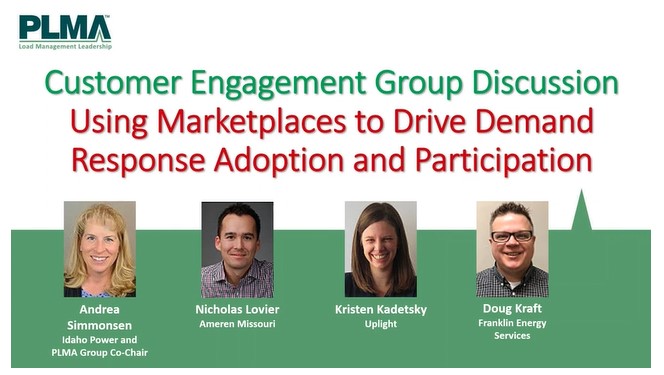 A growing number of utilities have launched or are considering online marketplaces aiming to engage customers effectively in an era of increasing online service offerings. Marketplaces offer customers a unique opportunity to purchase products or select services from their trusted energy advisor through a utility branded website. These marketplaces can be dynamic platforms that offer instant rebates, coupons, or promotional code-based discounts, while integrating with utility back end systems to verify customer program eligibility. In addition, the utility can introduce customers to new, innovative, and emerging products or services that customers won’t see in traditional retail outlets, and provide easy enrollment at the same time. A growing number of utilities have launched or are considering online marketplaces aiming to engage customers effectively in an era of increasing online service offerings. Marketplaces offer customers a unique opportunity to purchase products or select services from their trusted energy advisor through a utility branded website. These marketplaces can be dynamic platforms that offer instant rebates, coupons, or promotional code-based discounts, while integrating with utility back end systems to verify customer program eligibility. In addition, the utility can introduce customers to new, innovative, and emerging products or services that customers won’t see in traditional retail outlets, and provide easy enrollment at the same time.
Source: PLMA Dialogue featuring Scott Jarman, Austin Energy; Nicholas Lovier, Ameren Missouri; Kristen Kadetsky, Uplight; and Doug Kraft, Franklin Energy Services
Type: Webinar
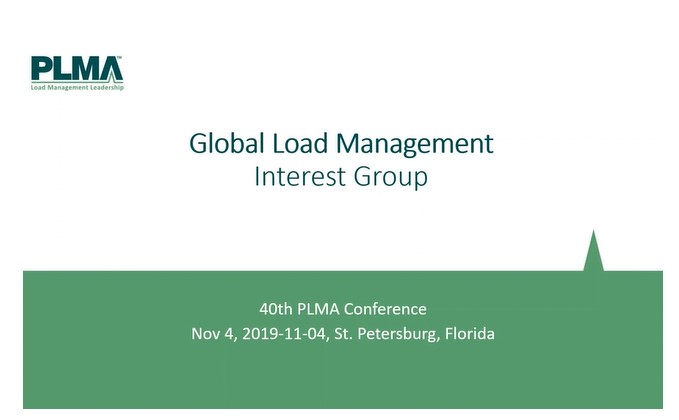 The PLMA Global Load Management interest group had a session at the 40th PLMA Conference to explore several innovative technologies coming from companies based in countries from around the world. In this recording, Mark Bailey of the UK-based Connected Energy will discuss the reuse of EV batteries for dynamic frequency response and power quality support. Tobais Weghorn of Germany-based Next Kraftwerke will discuss the aggregation of wind farms into a Virtual Power Plant to enhance performance in electricity trading. The session concludes with an interactive discussion with the panelists and interest group members, exploring where the United States is leading the way and where we may be lagging either other countries and or other markets. The PLMA Global Load Management interest group had a session at the 40th PLMA Conference to explore several innovative technologies coming from companies based in countries from around the world. In this recording, Mark Bailey of the UK-based Connected Energy will discuss the reuse of EV batteries for dynamic frequency response and power quality support. Tobais Weghorn of Germany-based Next Kraftwerke will discuss the aggregation of wind farms into a Virtual Power Plant to enhance performance in electricity trading. The session concludes with an interactive discussion with the panelists and interest group members, exploring where the United States is leading the way and where we may be lagging either other countries and or other markets.
Source: PLMA in-person session featuring Scott Coe, GridOptimize; Jon Hilowitz, Orange and Rockland Utilities; Ross Malme, Skipping Stone; Mark Bailey, Connected Energy Limited; and Tobias Weghorn, Next Kraftwerke
Type: Session recording
 This stakeholder event was part of NYSERDA’s development of a Carbon Neutral Buildings (CNB) Roadmap for New York State. NYSERDA is inviting subject matter experts to attend the fifth event on the ‘Grid-side of Building Electrification,’ focusing on: This stakeholder event was part of NYSERDA’s development of a Carbon Neutral Buildings (CNB) Roadmap for New York State. NYSERDA is inviting subject matter experts to attend the fifth event on the ‘Grid-side of Building Electrification,’ focusing on:
- Utility rate structures and other policy options to encourage high-performance, electric buildings that are also “grid-responsive,” providing demand flexibility to benefit a highly renewable grid; and
- Related technical challenges and opportunities, including building-level and smart grid solutions that are required to enable the large-scale electrification of buildings while preserving or enhancing grid reliability and resilience.
NYSERDA will use these discussions to guide the content in the Roadmap. Discussions will focus on defining high priority, actionable tasks in the near term, as well as considering more innovative, “out-of-the-box” ideas that could be undertaken over the next 15 years.
Source: Presentation given by Ed Thomas, PLMA Executive Director
Type: Presentation
October 2019
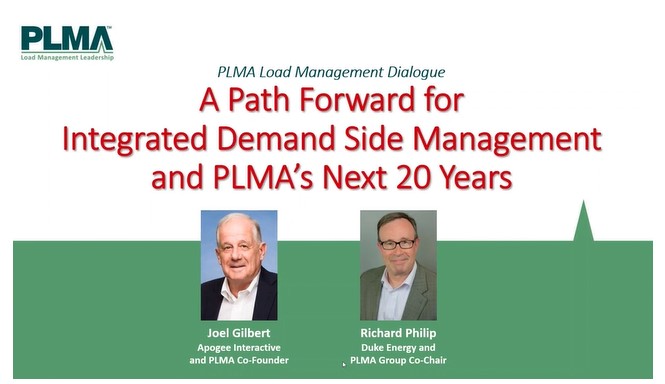 Joel Gilbert co-founded PLMA in 1999 because he foresaw the industry needed innovative thinking and a collaborative working group to solve the peak load management challenges of the day. As PLMA looks to celebrate its 20th anniversary in St., Petersburg this November, Joel believes the industry needs a bit of a “reset button” to move it past the “evolutionary incrementalism” and refinements of buggy whips it currently is considering. In this dialogue with Rich Philip from Duke Energy, Joel will outline the current impediments he sees to a survivable IDSM strategy and how PLMA members can work together to address those, just like we did back when PLMA first started. If these impediments are not addressed, he feels the assumption that technology and the IOT will not yield success. Joel’s concern is that we are just not facing the realities today in the current electricity pricing models both in wholesale and retail markets. He is also concerned that any technologies we might consider helpful are going to face the harsh reality of shrinking internal resources (especially within IT departments) and rising fears over data security and privacy risks, while senior leadership asks for clear monetized benefits and business cases that are still elusive or unprovable. Joel Gilbert co-founded PLMA in 1999 because he foresaw the industry needed innovative thinking and a collaborative working group to solve the peak load management challenges of the day. As PLMA looks to celebrate its 20th anniversary in St., Petersburg this November, Joel believes the industry needs a bit of a “reset button” to move it past the “evolutionary incrementalism” and refinements of buggy whips it currently is considering. In this dialogue with Rich Philip from Duke Energy, Joel will outline the current impediments he sees to a survivable IDSM strategy and how PLMA members can work together to address those, just like we did back when PLMA first started. If these impediments are not addressed, he feels the assumption that technology and the IOT will not yield success. Joel’s concern is that we are just not facing the realities today in the current electricity pricing models both in wholesale and retail markets. He is also concerned that any technologies we might consider helpful are going to face the harsh reality of shrinking internal resources (especially within IT departments) and rising fears over data security and privacy risks, while senior leadership asks for clear monetized benefits and business cases that are still elusive or unprovable.
Source: PLMA Dialogue featuring Joel Gilbert, Apogee Interactive and Richard Philip, Duke Energy
Type: Webinar
 Eversource Energy introduced an innovative holistic approach to reducing peak demand among commercial and industrial (C&I) customers. Their active-demand management demonstration utilized a wide range of technologies, including battery storage, ice storage, phase change material thermal storage, advanced software and controls and wi-fi thermostats, to engage large and small C&I customers. Not only did the demonstration successfully engage with a variety of C&I customers, it also reduced the 2018 regional peak by 8.7 MW. This demonstration project shows that taking a holistic approach to demand reduction is necessary for the long-term viability of demand-reduction programs and paved the way for the development of an approach to peak-demand management featuring various technology types, each using open communication protocols that connect to a single dispatch platform. Eversource Energy introduced an innovative holistic approach to reducing peak demand among commercial and industrial (C&I) customers. Their active-demand management demonstration utilized a wide range of technologies, including battery storage, ice storage, phase change material thermal storage, advanced software and controls and wi-fi thermostats, to engage large and small C&I customers. Not only did the demonstration successfully engage with a variety of C&I customers, it also reduced the 2018 regional peak by 8.7 MW. This demonstration project shows that taking a holistic approach to demand reduction is necessary for the long-term viability of demand-reduction programs and paved the way for the development of an approach to peak-demand management featuring various technology types, each using open communication protocols that connect to a single dispatch platform.
Source: PLMA Dialogue featuring Michael Goldman, Eversource Energy; and Michael Smith, National Grid
Type: Webinar
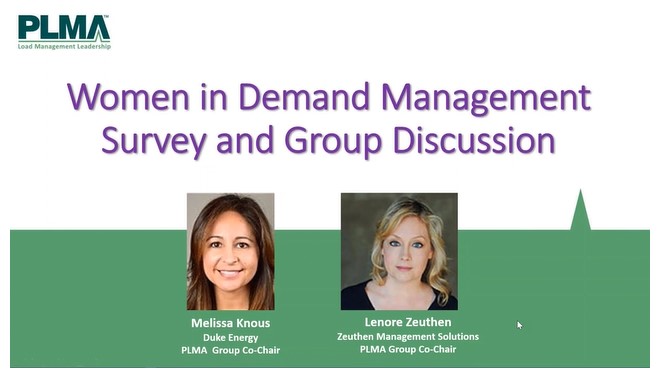 The Group Co-chairs want your input about the PLMA Women in Demand Management Interest Group, even if you are not a member or a woman. The survey at www.surveymonkey.com/r/Women-in-DM-2019-Survey will take less than 3 minutes to complete. Individual responses are confidential. Please encourage your fellow PLMA members to respond to this survey. The survey results will be shared during the October 23 webcast. According to the U.S. Dept. of Labor, women constitute only 21.4% of the utilities workforce. Join this Women in Demand Management Group Discussion to hear the results of our 2019 survey and discuss our priorities for 2020. All are welcome - we want your questions and suggestions, and are seeking volunteers to work with us on an expanded schedule of activities. The Group Co-chairs want your input about the PLMA Women in Demand Management Interest Group, even if you are not a member or a woman. The survey at www.surveymonkey.com/r/Women-in-DM-2019-Survey will take less than 3 minutes to complete. Individual responses are confidential. Please encourage your fellow PLMA members to respond to this survey. The survey results will be shared during the October 23 webcast. According to the U.S. Dept. of Labor, women constitute only 21.4% of the utilities workforce. Join this Women in Demand Management Group Discussion to hear the results of our 2019 survey and discuss our priorities for 2020. All are welcome - we want your questions and suggestions, and are seeking volunteers to work with us on an expanded schedule of activities.
Source: PLMA Dialogue featuring Melissa Knous, Duke Energy and Lenore Zeuthen, Zeuthen Management Solutions
Type: Webinar
 A growing number of utilities have launched or are considering online marketplaces aiming to engage customers effectively in an era of increasing online service offerings. Marketplaces offer customers a unique opportunity to purchase products or select services from their trusted energy advisor through a utility branded website. These marketplaces can be dynamic platforms that offer instant rebates, coupons, or promotional code-based discounts, while integrating with utility back end systems to verify customer program eligibilty. In addition, the utility can introduce customers to new, innovative, and emerging products or services that customers won’t see in traditional retail outlets, and provide easy enrollment at the same time. A growing number of utilities have launched or are considering online marketplaces aiming to engage customers effectively in an era of increasing online service offerings. Marketplaces offer customers a unique opportunity to purchase products or select services from their trusted energy advisor through a utility branded website. These marketplaces can be dynamic platforms that offer instant rebates, coupons, or promotional code-based discounts, while integrating with utility back end systems to verify customer program eligibilty. In addition, the utility can introduce customers to new, innovative, and emerging products or services that customers won’t see in traditional retail outlets, and provide easy enrollment at the same time.
Source: PLMA Dialogue featuring Scott Jarman, Austin Energy; Nicholas Lovier, Ameren Missouri; Kristen Kadetsky, Uplight; and Doug Kraft, Franklin Energy Services
Type: Webinar
September 2019
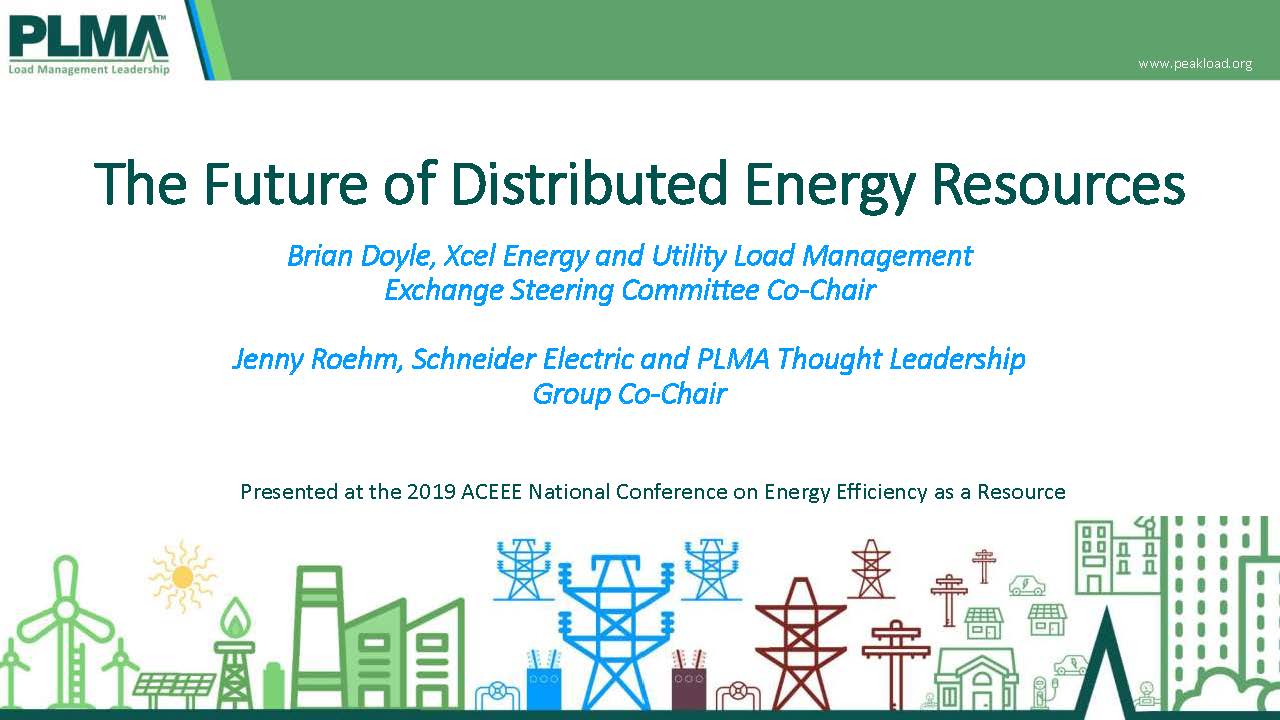 Where do today's load management activities (including demand response, energy efficiency, and renewable energy programs) fit in a distributed energy resource (DER) future of non-wires alternatives, storage and more? Discover key takeaways from a recent PLMA publication that detailed 8 industry initiatives where leading utilities are partnering with allies to demonstrate the path to a more integrated approach to DERs. Gain insight from case studies that showcase: Where do today's load management activities (including demand response, energy efficiency, and renewable energy programs) fit in a distributed energy resource (DER) future of non-wires alternatives, storage and more? Discover key takeaways from a recent PLMA publication that detailed 8 industry initiatives where leading utilities are partnering with allies to demonstrate the path to a more integrated approach to DERs. Gain insight from case studies that showcase:
- Planning/Foundational Issues where utilities are taking bold steps to leapfrog pilots/technology straight to integrative planning and procuring, and change management;
- “DR Plus” case studies where customer-sited assets (with or without involvement of an aggregator) are used to monetize DER operations for utility/grid benefits to a growing spectrum of network problems;
- Microgrid examples where customer-sited assets that have great degrees of flexibility and opportunity for monetization; and
- International case studies of first movers in DER.
Source: Presentation by Brian Doyle, Xcel Energy and Jenny Roehm, Schneider Electric given on Oct. 16, 2019 at 2019 National Conference on Energy Efficiency as a Resource, Minneapolis, Minn.
Type: Presentation
 Commercial & industrial freezers (10,000 to 200,000+ square feet) in the food and beverage, foodservice, grocery, and cold storage industries require massive amounts of electricity to keep frozen food product temperatures stable between 0 and -20 degrees Fahrenheit. These facilities maintain the highest demand per cubic foot of any industrial category and globally spend over $40 billion on energy every year. Commercial & industrial freezers (10,000 to 200,000+ square feet) in the food and beverage, foodservice, grocery, and cold storage industries require massive amounts of electricity to keep frozen food product temperatures stable between 0 and -20 degrees Fahrenheit. These facilities maintain the highest demand per cubic foot of any industrial category and globally spend over $40 billion on energy every year.
Viking Cold Solutions uses thermal energy storage systems (TES) to utilize frozen food facilities in the United States, Mexico, the Caribbean, and Australia as grid assets that enable operators to shed 300-500 kW for up to 13 hours each day. TES systems leverage the facility’s existing refrigeration system to store energy in the form of cold and discharge that energy over long periods of time when it is most economical for the grid and the facility operator. These systems have no mechanical components and use phase change material, to absorb up to 85% of the heat infiltration while refrigeration is cycled off, and intelligent controls to balance temperature requirements and energy use. With a levelized cost of energy of less than 2¢ per kWh, many power providers have added TES technology into their efficiency and demand management programs to improve efficiency an average of 26%, help address the variability of renewables, and unlock large-scale demand management opportunities for a fraction of the cost of other storage mediums.
Source: PLMA Interest Group Dialogue featuring Collin Coker, Viking Cold Solutions; and Michael Smith, National Grid
Type: Webinar
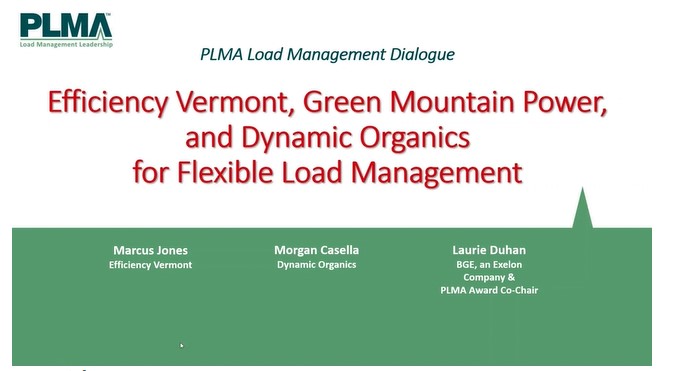 This project demonstrated the importance of partnerships for successful peak load management to benefit Vermonters, reducing carbon and the overall cost of the energy delivery system. Efficiency Vermont had a long-term customer relationship with Brattleboro Retreat, a healthcare facility in Southern Vermont. The project renewed utilization and controls optimization for a 1990s legacy, 3.2 MWh chiller and ice storage system. This project demonstrated the importance of partnerships for successful peak load management to benefit Vermonters, reducing carbon and the overall cost of the energy delivery system. Efficiency Vermont had a long-term customer relationship with Brattleboro Retreat, a healthcare facility in Southern Vermont. The project renewed utilization and controls optimization for a 1990s legacy, 3.2 MWh chiller and ice storage system.
Green Mountain Power, the local utility committed to fighting climate change, developed a strategy to share grid benefit and savings with customers from shifting load off peak. Dynamic Organics developed a custom controller and dashboard incorporating weather, electric grid demand and pricing, and HVAC system data simultaneously to allow remote control and automated operation of the ice storage system. A trial of the system during an early summer peak event was successful, and that led to development of an innovative pilot (currently enrolling 10 more customers with diverse flexible assets) to demonstrate grid and customer value. The goal is to then make this a permanent rate option for commercial customers who have flexible load.
Source: PLMA Interest Group Dialogue featuring Marcus Jones, Efficiency Vermont; Morgan Casella, Dynamic Organics; and Laurie Duhan, BGE
Type: Webinar
August 2019
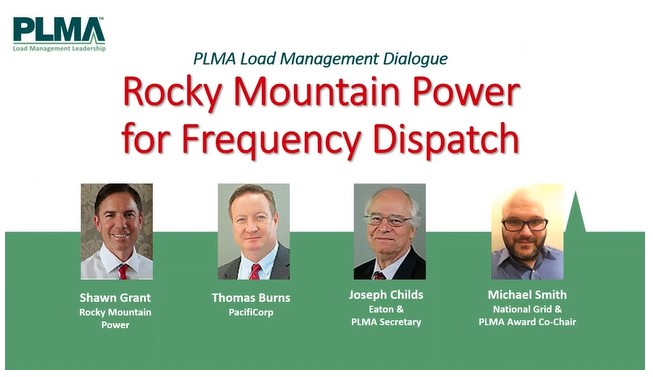 PacifiCorp demonstrated that Demand Response (DR) resources can be used to deliver GridScale Fast DR to meet frequency dispatch and BAL 3 requirements. This project demonstrated that the Cool Keeper system could be used in an additional capacity with very tight control response. PacifiCorp designed and implemented the automatic dispatch of residential customers enrolled in the Rocky Mountain Power Cool Keeper program utilizing Eaton’s two-way devices and Yukon portal to respond to frequency dispatch signals. To comply as frequency dispatch, the resources must immediately begin providing support once dispatched and be fully activated within 50 seconds from event detection. The BAL 3 measurement is a performance curve during this resource dispatch period. The solution resulted in an average of 64 MW of BAL 3 resources and over 100 MW of load drop across several events during the 2018 summer DR control season. Performance was measured and calculated using two second system metered data collected by the PacifiCorp Energy Management System. PacifiCorp demonstrated that Demand Response (DR) resources can be used to deliver GridScale Fast DR to meet frequency dispatch and BAL 3 requirements. This project demonstrated that the Cool Keeper system could be used in an additional capacity with very tight control response. PacifiCorp designed and implemented the automatic dispatch of residential customers enrolled in the Rocky Mountain Power Cool Keeper program utilizing Eaton’s two-way devices and Yukon portal to respond to frequency dispatch signals. To comply as frequency dispatch, the resources must immediately begin providing support once dispatched and be fully activated within 50 seconds from event detection. The BAL 3 measurement is a performance curve during this resource dispatch period. The solution resulted in an average of 64 MW of BAL 3 resources and over 100 MW of load drop across several events during the 2018 summer DR control season. Performance was measured and calculated using two second system metered data collected by the PacifiCorp Energy Management System.
Source: PLMA Interest Group Dialogue featuring Shawn Grant, Rocky Mountain Power; Thomas Burns, PacifiCorp; Joe Childs, Eaton; and Michael Smith, National Grid
Type: Webinar
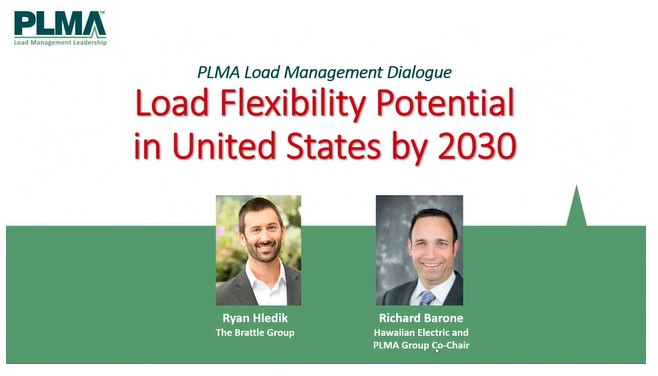 A recent study by The Brattle group identified nearly 200 GW of cost-effective load flexibility potential in the U.S. by 2030. This load flexibility potential, which equates to 20% of estimated U.S. peak load in 2030, would more than triple the existing demand response (DR) capability and would be worth more than $15 billion annually in avoided system costs. A recent study by The Brattle group identified nearly 200 GW of cost-effective load flexibility potential in the U.S. by 2030. This load flexibility potential, which equates to 20% of estimated U.S. peak load in 2030, would more than triple the existing demand response (DR) capability and would be worth more than $15 billion annually in avoided system costs.
Click here to view the free report.
Source: PLMA Interest Group Dialogue featuring Ryan Hledik, The Brattle Group, and Richard Barone, Hawaiian Electric
Type: Webinar
July 2019
 A team from the Pacific Northwest spearheaded by three individuals — Tony Koch of the Bonneville Power Administration, Conrad Eustis of Portland General Electric, and Geoff Wickes of Northwest Energy Efficiency Alliance — demonstrated that funding shipments of only smart, DR-enabled water heaters into the Pacific NW would be cost justified to enable a new paradigm for “connected” technologies. The “smart”, electric resistance and heat pump water heaters were equipped with ANSI/CTA-2045, a new modular communications standard designed for all major appliances that enables a simple, and identical customer experience for enabling communication and smart management. Beyond simple peak-load management, the project demonstrated daily use of the water heaters as energy storage assets, with high customer satisfaction. A team from the Pacific Northwest spearheaded by three individuals — Tony Koch of the Bonneville Power Administration, Conrad Eustis of Portland General Electric, and Geoff Wickes of Northwest Energy Efficiency Alliance — demonstrated that funding shipments of only smart, DR-enabled water heaters into the Pacific NW would be cost justified to enable a new paradigm for “connected” technologies. The “smart”, electric resistance and heat pump water heaters were equipped with ANSI/CTA-2045, a new modular communications standard designed for all major appliances that enables a simple, and identical customer experience for enabling communication and smart management. Beyond simple peak-load management, the project demonstrated daily use of the water heaters as energy storage assets, with high customer satisfaction.
Source: PLMA Interest Group Dialogue featuring Tony Koch, BPA and Conrad Eustis, Portland General Electric; and Laurie Duhan, BGE
Type: Webinar
June 2019
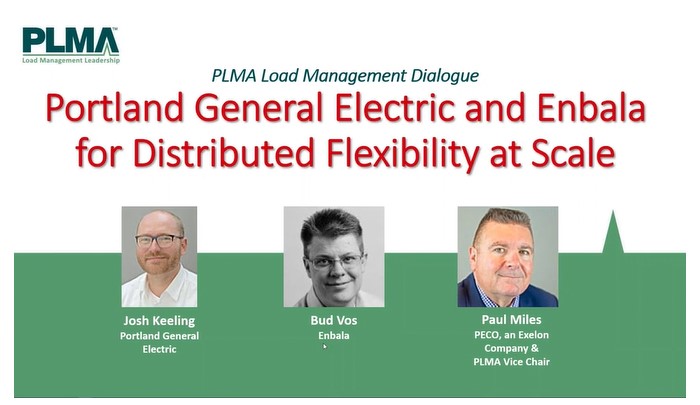 Portland General Electric (PGE) has created a technology agnostic, interoperable virtual power plant (VPP) in collaboration with Enbala that enables PGE to offer control, optimization, and demand management of an entire fleet of DERs across various customers, vendors and programs. This multi-program-multi-vendor-ecosystem allows for the customization across DER asset-types, location, participation schedules, and service offerings, while providing visibility into, and integration of, data in an approach that is scalable, sustainable, futureproof, and customer-focused. Portland General Electric (PGE) has created a technology agnostic, interoperable virtual power plant (VPP) in collaboration with Enbala that enables PGE to offer control, optimization, and demand management of an entire fleet of DERs across various customers, vendors and programs. This multi-program-multi-vendor-ecosystem allows for the customization across DER asset-types, location, participation schedules, and service offerings, while providing visibility into, and integration of, data in an approach that is scalable, sustainable, futureproof, and customer-focused.
Source: PLMA Interest Group Dialogue featuring Josh Keeling, Portland General Electric; Bud Vos, Enbala; and Paul Miles, PECO, an Exelon Company
Type: Webinar
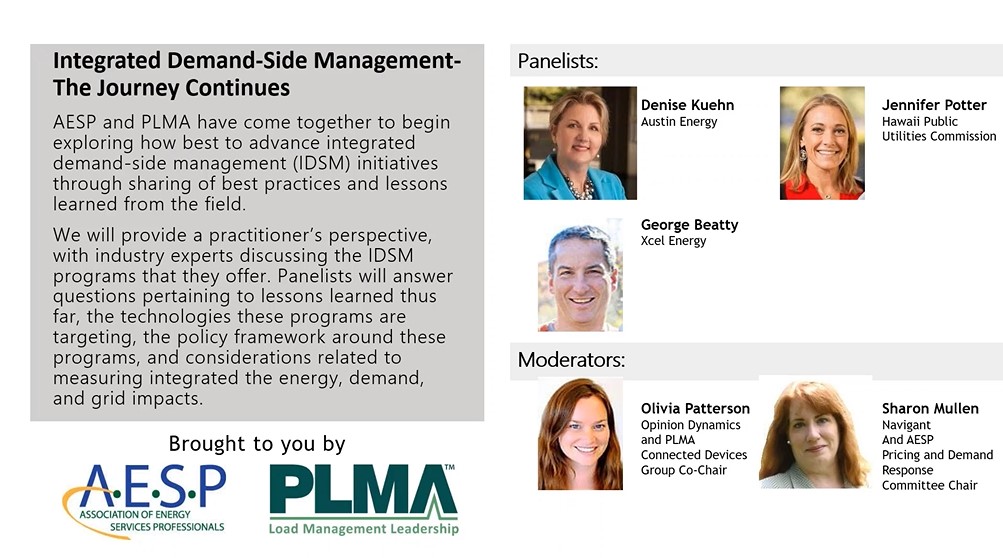 Traditionally, utilities have separated their energy efficiency (EE) and demand response (DR) portfolios into distinct, and isolated, portfolios. As distributed energy resources (DERs) are deployed across the distribution grid and policy mandates shift, utilities and implementers are repurposing their demand-side management (DSM) programs (e.g., energy efficiency, demand response, distributed energy, and energy storage) toward integrated approaches that take advantage of natural synergies using advances in technology and customer engagement. These integrated programs focus on technologies with functionality to decrease, store, or increase both energy usage and demand, thereby combining EE, DR and DER programs. Traditionally, utilities have separated their energy efficiency (EE) and demand response (DR) portfolios into distinct, and isolated, portfolios. As distributed energy resources (DERs) are deployed across the distribution grid and policy mandates shift, utilities and implementers are repurposing their demand-side management (DSM) programs (e.g., energy efficiency, demand response, distributed energy, and energy storage) toward integrated approaches that take advantage of natural synergies using advances in technology and customer engagement. These integrated programs focus on technologies with functionality to decrease, store, or increase both energy usage and demand, thereby combining EE, DR and DER programs.
Source: PLMA Interest Group Dialogue featuring Denise Kuehn, Austin Energy; Jennifer Potter, Hawaii PUC; and George Beatty, Xcel Energy
Type: Webinar
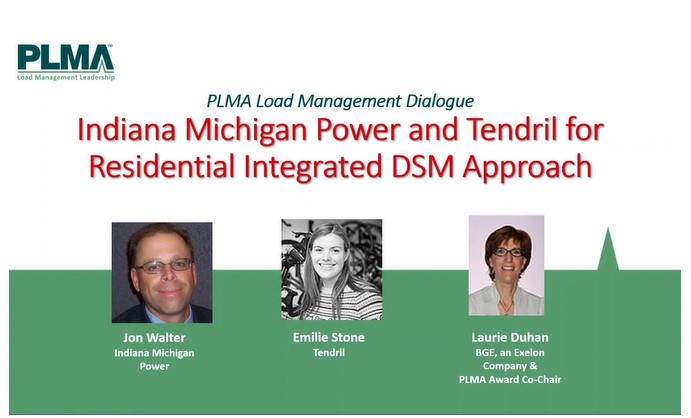 Indiana Michigan Power (I&M) worked with Tendril to implement Orchestrated Energy, a connected thermostat demand response program dramatically shifting peak load and improving the energy efficiency beyond that of smart thermostats, without sacrificing customer comfort. I&M uses this program as a customer engagement tool that also provides demand response load while keeping customers comfortable. I&M envisions this program as another way to become a trusted energy advisor to their customers on how to utilize the connected home. Indiana Michigan Power (I&M) worked with Tendril to implement Orchestrated Energy, a connected thermostat demand response program dramatically shifting peak load and improving the energy efficiency beyond that of smart thermostats, without sacrificing customer comfort. I&M uses this program as a customer engagement tool that also provides demand response load while keeping customers comfortable. I&M envisions this program as another way to become a trusted energy advisor to their customers on how to utilize the connected home.
Source: PLMA Interest Group Dialogue featuring Jon Walter, Indiana Michigan Power; Emilie Stone, Tendril; and Laurie Duhan, BGE
Type: Webinar
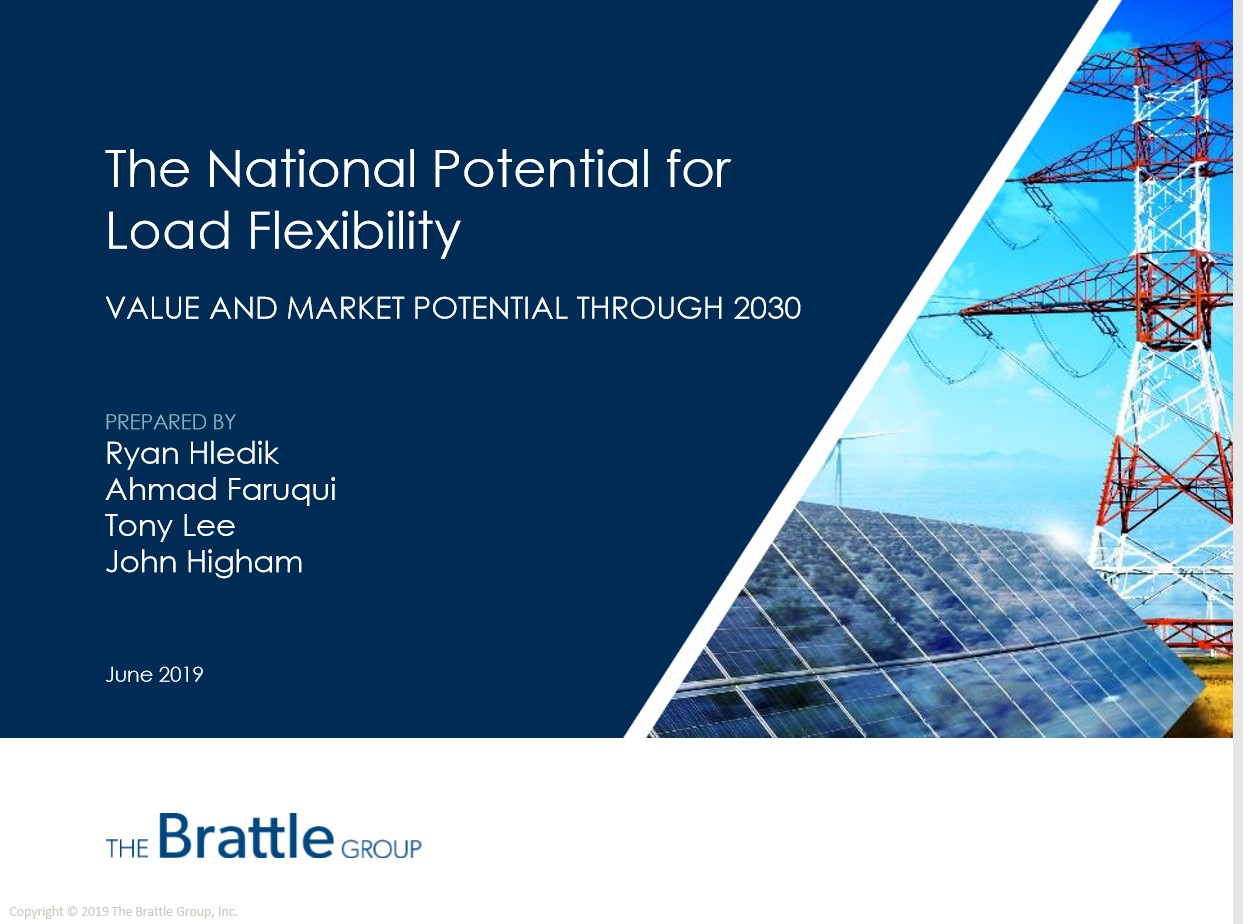 Economists at The Brattle Group have released a new study that identifies nearly 200 GW of cost-effective load flexibility potential in the U.S. by 2030. This load flexibility potential, which equates to 20% of estimated U.S. peak load in 2030, would more than triple the existing demand response (DR) capability and would be worth more than $15 billion annually in avoided system costs. The Brattle study combines insights from a number of client engagements conducted to assess the value and market potential of emerging load flexibility opportunities across various jurisdictions in North America. Historically, conventional DR has provided significant value through peak demand reductions. Economists at The Brattle Group have released a new study that identifies nearly 200 GW of cost-effective load flexibility potential in the U.S. by 2030. This load flexibility potential, which equates to 20% of estimated U.S. peak load in 2030, would more than triple the existing demand response (DR) capability and would be worth more than $15 billion annually in avoided system costs. The Brattle study combines insights from a number of client engagements conducted to assess the value and market potential of emerging load flexibility opportunities across various jurisdictions in North America. Historically, conventional DR has provided significant value through peak demand reductions.
Source: The Brattle Group
Type: Webinar
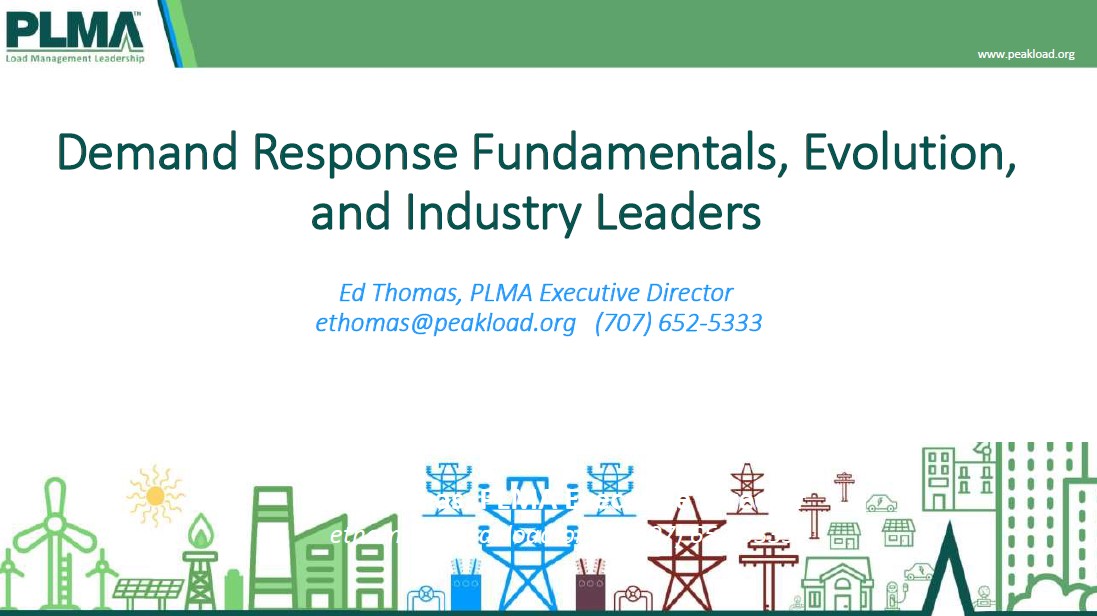 Demand Response Fundamentals, Evolution, and Industry Leaders This presentation provides an overview of the happenings within PLMA and other industry practitioners. Highlights covered include PLMA introducing a new logo, articles posted in Utility Dive, joint webinars with other industry organizations and PLMA members speaking at various conferences and publishing reports. Demand Response Fundamentals, Evolution, and Industry Leaders This presentation provides an overview of the happenings within PLMA and other industry practitioners. Highlights covered include PLMA introducing a new logo, articles posted in Utility Dive, joint webinars with other industry organizations and PLMA members speaking at various conferences and publishing reports.
Source: PLMA
Type: Presentation
May 2019
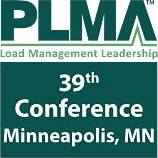 Presentations and other resources from the 39th PLMA Conference on May 13-15 in Minneapolis, MN Presentations and other resources from the 39th PLMA Conference on May 13-15 in Minneapolis, MN
Source: PLMA
Type: Presentations
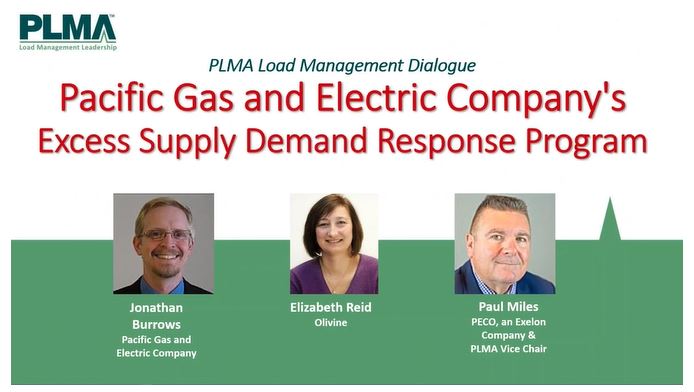 The Pacific Gas and Electric Company (PG&E) Excess Supply Demand Response program (XSP) demonstrates capabilities of demand-side resources to consume or decrease load as a service to the grid to address intermittency due to oversupply of renewables generation as distributed generation accelerates. The California PUC Load Shift Working Group noted in 2018 that the XSP was the only existing load shifting participation model. Designed to capture the full value of flexible resources to the grid it has been incorporated into initiatives across various consumer types including the California Energy Commission EPIC Total Charge Management project, PG&E’s Electric Vehicle Charge Network Load Management Plan, and the Pittsburg USD School Bus Renewables Integration Project. The Pacific Gas and Electric Company (PG&E) Excess Supply Demand Response program (XSP) demonstrates capabilities of demand-side resources to consume or decrease load as a service to the grid to address intermittency due to oversupply of renewables generation as distributed generation accelerates. The California PUC Load Shift Working Group noted in 2018 that the XSP was the only existing load shifting participation model. Designed to capture the full value of flexible resources to the grid it has been incorporated into initiatives across various consumer types including the California Energy Commission EPIC Total Charge Management project, PG&E’s Electric Vehicle Charge Network Load Management Plan, and the Pittsburg USD School Bus Renewables Integration Project.
Source: PLMA Interest Group Dialogue featuring Jonathan Burrows, PG&E; Elizabeth Reid, Olivine; and Paul Miles, PECO, an Exelon Company
Type: Webinar
 PLMA sponsored the creation of this Utility Dive initiative to examines the experiences of various utilities, vendors, states and grid operators to provide a comprehensive picture of a burgeoning field at the heart of the energy transition. PLMA sponsored the creation of this Utility Dive initiative to examines the experiences of various utilities, vendors, states and grid operators to provide a comprehensive picture of a burgeoning field at the heart of the energy transition.
Click here to read the article.
Source: PLMA and Utility Dive
Type: Article
April 2019
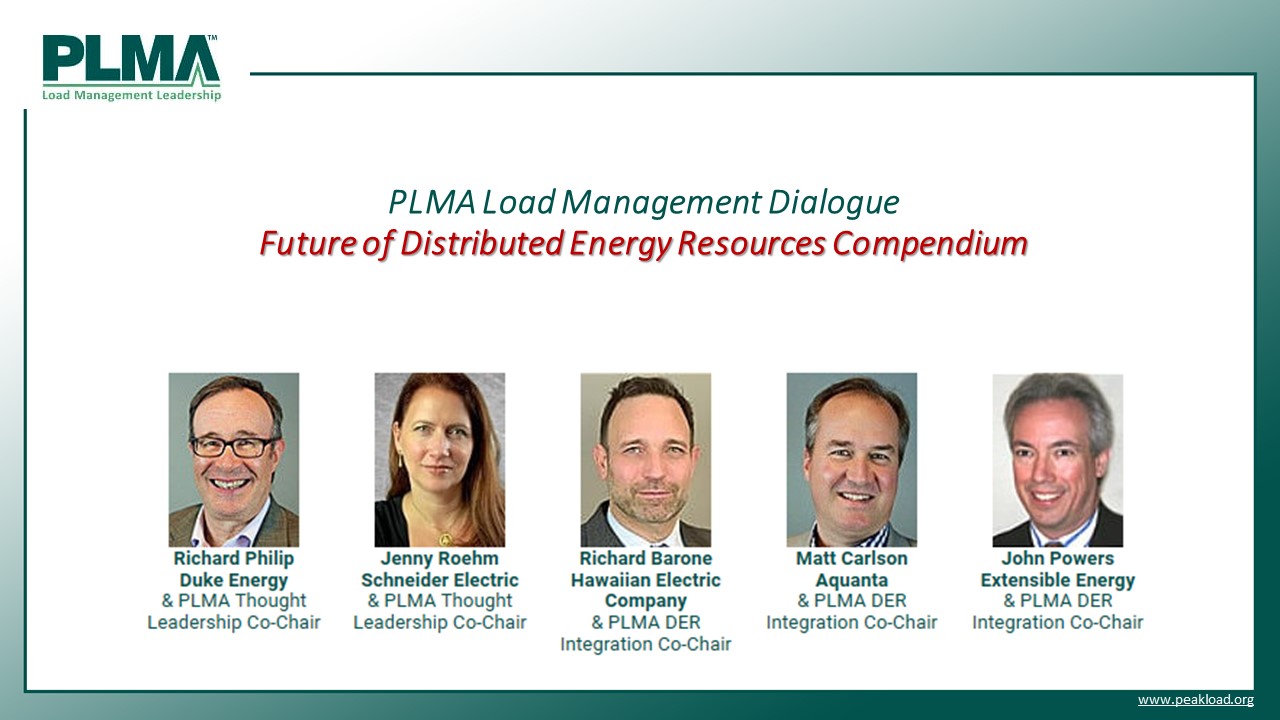 A new compendium published by PLMA details eight industry initiatives where leading utilities are partnering with their customers and allies to demonstrate the path to a more integrated approach to distributed energy resources. Where do today's load management activities (including demand response, energy efficiency, and renewable energy programs fit in a distributed energy resource future of non-wires alternatives, energy storage, and more? A new compendium published by PLMA details eight industry initiatives where leading utilities are partnering with their customers and allies to demonstrate the path to a more integrated approach to distributed energy resources. Where do today's load management activities (including demand response, energy efficiency, and renewable energy programs fit in a distributed energy resource future of non-wires alternatives, energy storage, and more?
Source: PLMA Interest Group Dialogue featuring Richard Philip, Duke Energy; Jenny Roehm, Schneider Electric; Richard Barone, Hawaiian Electric; John Powers, Extensible Energy; and Matt Carlson, Aquanta
Type: Webinar
March 2019
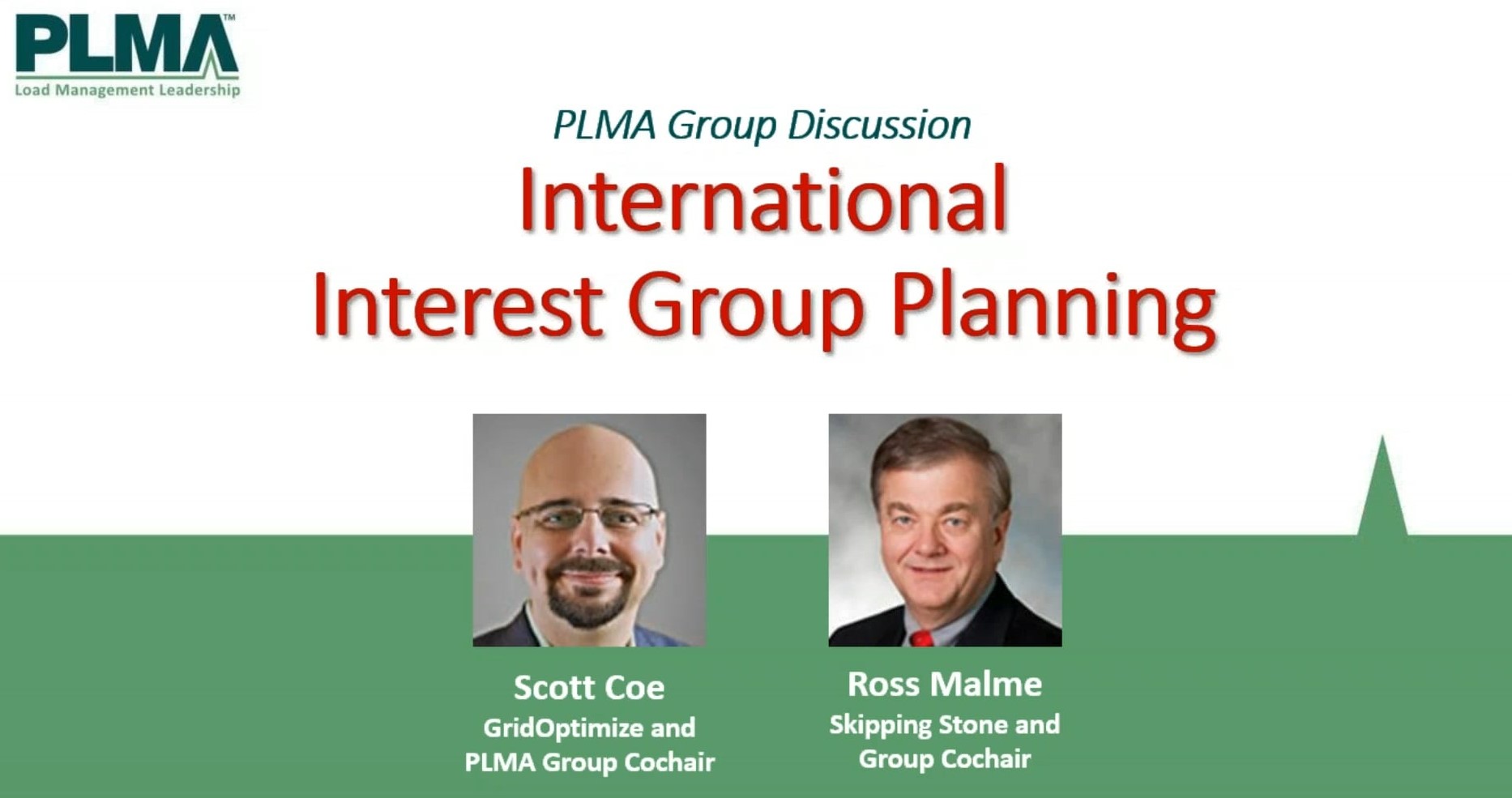 An online planning call to solidify short-term plans for the group, including a discussion of ideas for upcoming webcasts and the agenda for the 39th PLMA Conference in Minneapolis in May. We plan on introducing the “Country Of The Conference” concept for each PLMA conference, with the first being Japan – given both co-chairs have some experience in the country and there are several members in PLMA from Japan. Please join us to both hear thoughts from the group leadership as well as contribute your suggestions and ideas for contributing to the group goals. An online planning call to solidify short-term plans for the group, including a discussion of ideas for upcoming webcasts and the agenda for the 39th PLMA Conference in Minneapolis in May. We plan on introducing the “Country Of The Conference” concept for each PLMA conference, with the first being Japan – given both co-chairs have some experience in the country and there are several members in PLMA from Japan. Please join us to both hear thoughts from the group leadership as well as contribute your suggestions and ideas for contributing to the group goals.
Source: PLMA Interest Group Dialogue featuring Scott Coe, GridOptimize and Ross Malme, Skipping Stone
Type: Webinar
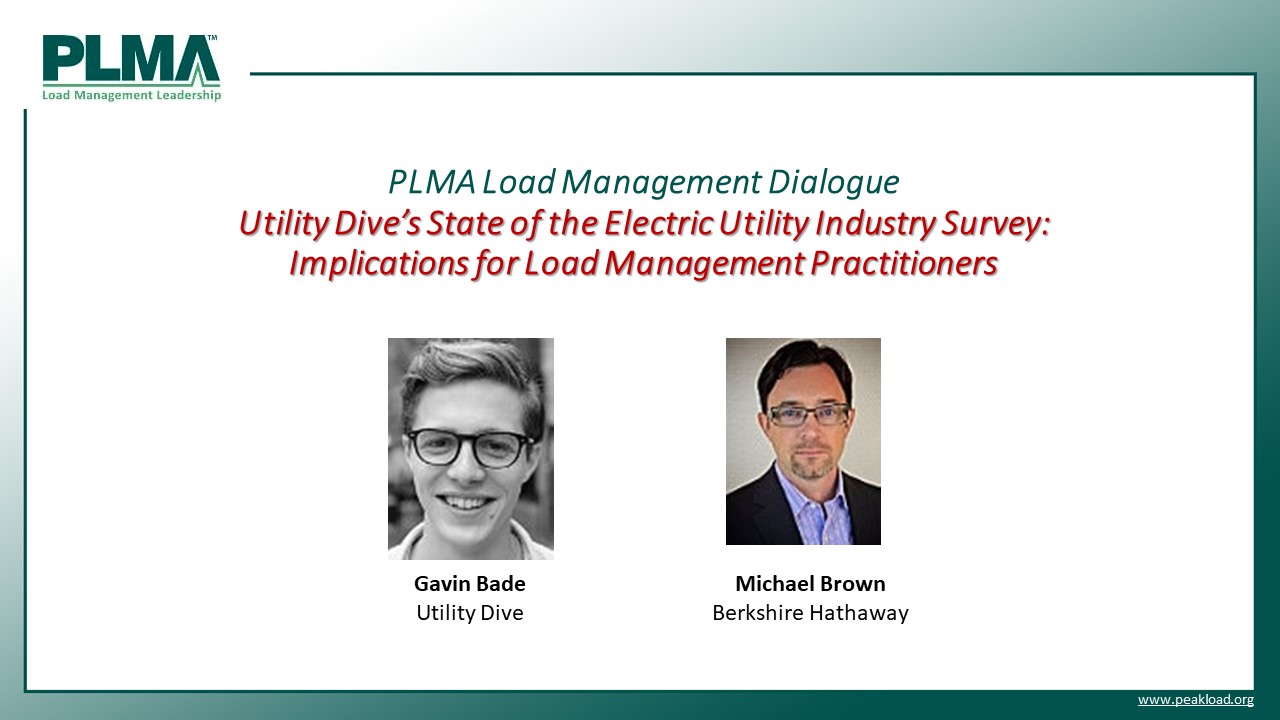 A discussion about implications for Load Management practitioners from Utility Dive's Annual State of the Electric Utility Industry Survey. A discussion about implications for Load Management practitioners from Utility Dive's Annual State of the Electric Utility Industry Survey.
Click here to view the Utility Dive report.
Source: PLMA Load Management Dialogue featuring Gavin Bade, Utility Dive, and Michael Brown, NV Energy and PLMA Chair
Type: Webinar
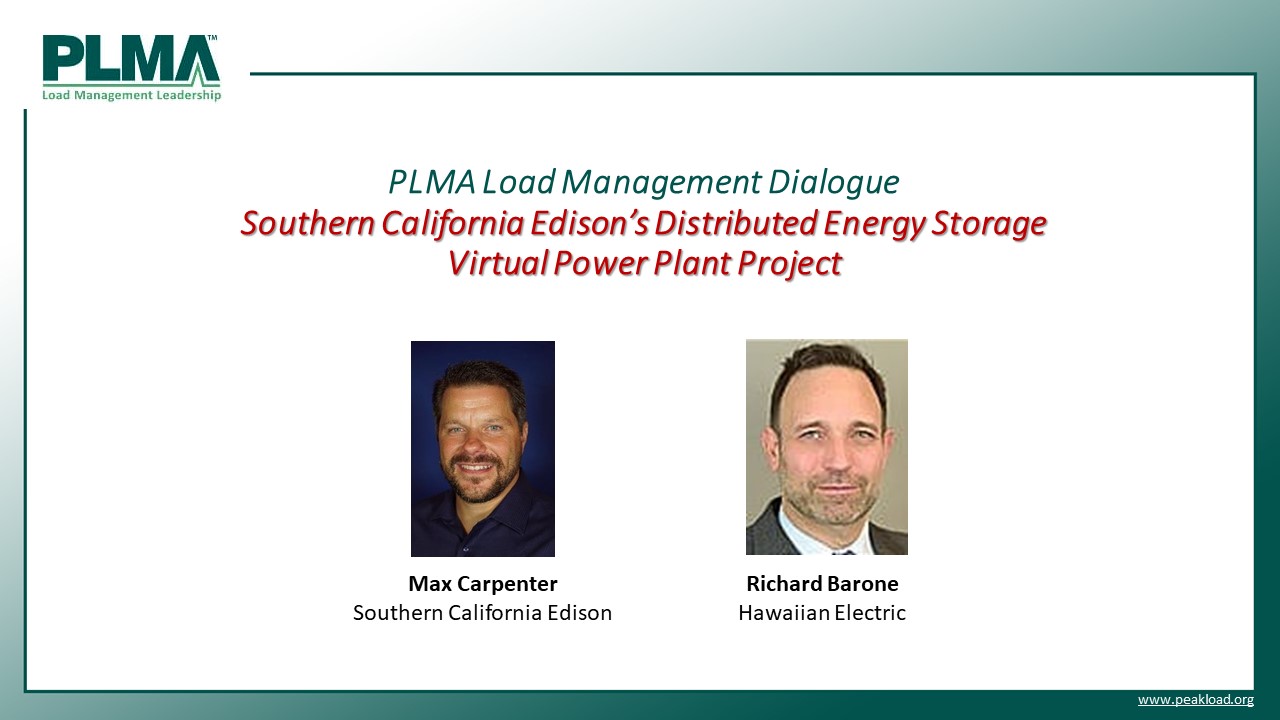 Gain key insights into Southern California's non-wires alternatives project which is one of the 10 leading case studies featured in a research report funded by E4TheFuture. Gain key insights into Southern California's non-wires alternatives project which is one of the 10 leading case studies featured in a research report funded by E4TheFuture.
Click here to view the report.
Discover key considerations from two leading non-wires-alternatives (NWA) projects. This 85 MW project active since December 2016 is perhaps the most sophisticated DER-provided capacity and NWA project in North America. It incorporates demand response with battery storage available for up to 4 hours when dispatched in West Los Angeles Basin, including parts of Orange and Los Angeles Counties, in California. It was the first large-scale test of customer-sited resources for SCE and its size demonstrates that NWA projects can provide more extensive lessons learned.
Source: PLMA Load Management Dialogue featuring Max Carpenter, Southern California Edison and Richard Barone, Hawaiian Electric
Type: Webinar
February 2019
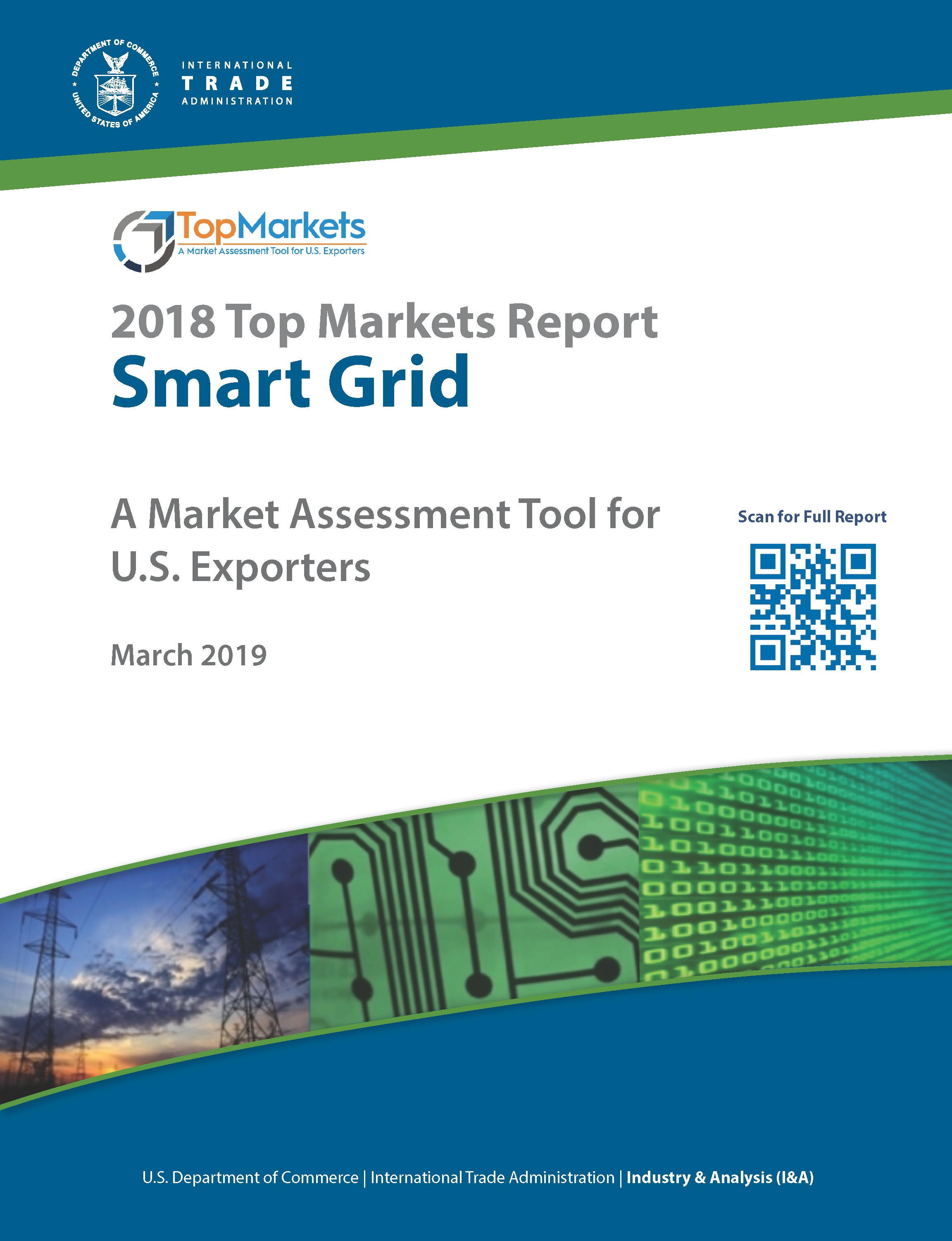 ITA's 2018 Smart Grid Top Markets Report ranks 56 international markets in terms of growth potential for the U.S. smart grid industry. The Report also analyzes the sub-sectors of transmission and distribution (T&D) equipment; smart grid information communication technologies (ICT); and energy storage. The report integrates data and analyses on global markets and trade, including the critical contributions of commercial specialists from U.S. Commercial Service posts. The results are combined using a weighted scorecard methodology to produce relative rankings of the 56 subject markets. ITA's 2018 Smart Grid Top Markets Report ranks 56 international markets in terms of growth potential for the U.S. smart grid industry. The Report also analyzes the sub-sectors of transmission and distribution (T&D) equipment; smart grid information communication technologies (ICT); and energy storage. The report integrates data and analyses on global markets and trade, including the critical contributions of commercial specialists from U.S. Commercial Service posts. The results are combined using a weighted scorecard methodology to produce relative rankings of the 56 subject markets.
Source: International Trade Administration (ITA)
Type: Report
 This presentation provides an overview of PLMA’s role in sharing load management expertise with the energy utility industry. This presentation provides an overview of PLMA’s role in sharing load management expertise with the energy utility industry.
Source: Ed Thomas, PLMA for the APS Integrated Resource Plan Working Group Meeting
Type: Presentation
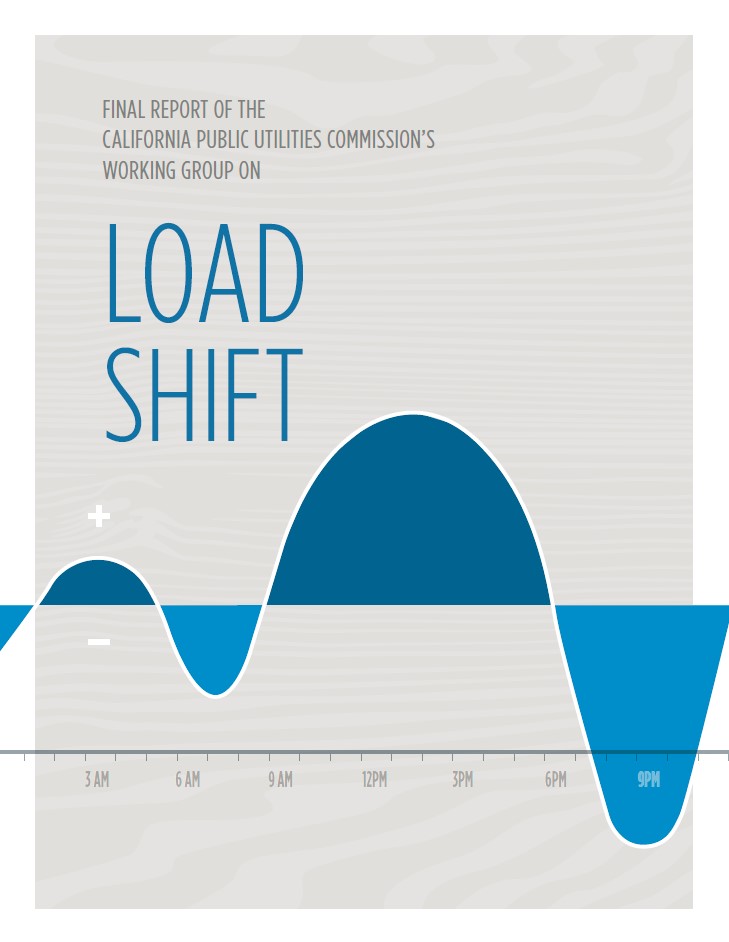 As California progresses toward its goal of 100% carbon-free electricity, Load Shift could play an increasingly significant role. The 2025 California Demand Response Potential Study, suggests that beginning in 2025 up to $600 million (2015$) could be saved annually by shifting load to avoid the curtailment of renewable generation. The Working Group met 11 times in 2018 with facilitation and support from Gridworks and the Commission’s Energy Division. Working collaboratively, a representative cross-section of stakeholders developed six different proposals on how Load Shift could be designed, sourced, incentivized and evaluated. This package of proposals provides a diverse range of options through which California can begin to actively test, refine and develop the Load Shift market needed to reach a 100% carbon-free grid. As California progresses toward its goal of 100% carbon-free electricity, Load Shift could play an increasingly significant role. The 2025 California Demand Response Potential Study, suggests that beginning in 2025 up to $600 million (2015$) could be saved annually by shifting load to avoid the curtailment of renewable generation. The Working Group met 11 times in 2018 with facilitation and support from Gridworks and the Commission’s Energy Division. Working collaboratively, a representative cross-section of stakeholders developed six different proposals on how Load Shift could be designed, sourced, incentivized and evaluated. This package of proposals provides a diverse range of options through which California can begin to actively test, refine and develop the Load Shift market needed to reach a 100% carbon-free grid.
Source: California Public Utilities Commission's Working Group
Type: Report
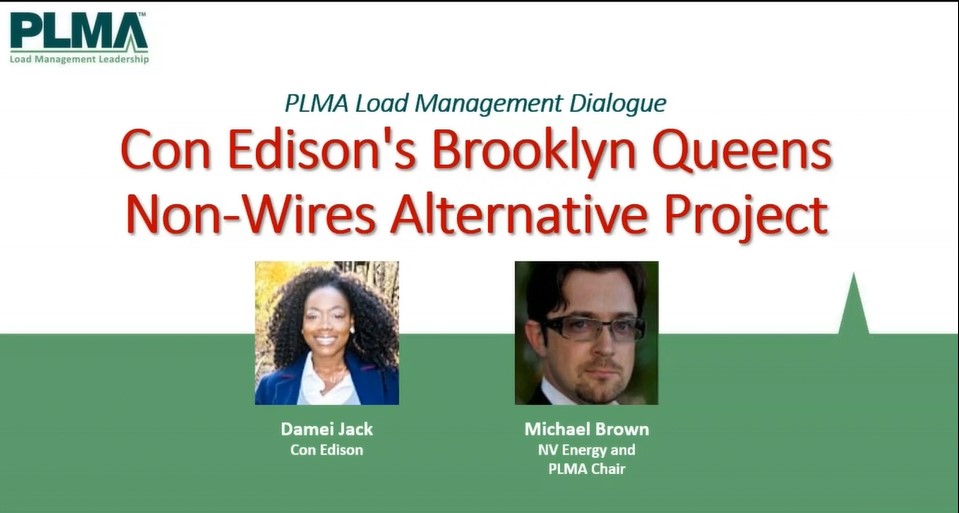 Discover key considerations from this leading non-wires-alternatives (NWA) project to deferring the need for traditional electric grid infrastructure upgrades. This discussion will share insight regarding project identification, procurement processes, benefit cost analysis tool development, and rate case incentives. Discover key takeaways and lessons learned from this first large program ConEd implemented and how it led to a streamlined approach of identifying and implementing newer projects. Hear how they found different ways to communicate these projects to the market and are working to continuously improve their approach to non-wires solutions, with customers and market partners in mind. Discover key considerations from this leading non-wires-alternatives (NWA) project to deferring the need for traditional electric grid infrastructure upgrades. This discussion will share insight regarding project identification, procurement processes, benefit cost analysis tool development, and rate case incentives. Discover key takeaways and lessons learned from this first large program ConEd implemented and how it led to a streamlined approach of identifying and implementing newer projects. Hear how they found different ways to communicate these projects to the market and are working to continuously improve their approach to non-wires solutions, with customers and market partners in mind.
Source: Load Management Dialogue with Damei Jack, Con Edison and Michael Brown, Berkshire Hathaway NV Energy
Type: Webinar
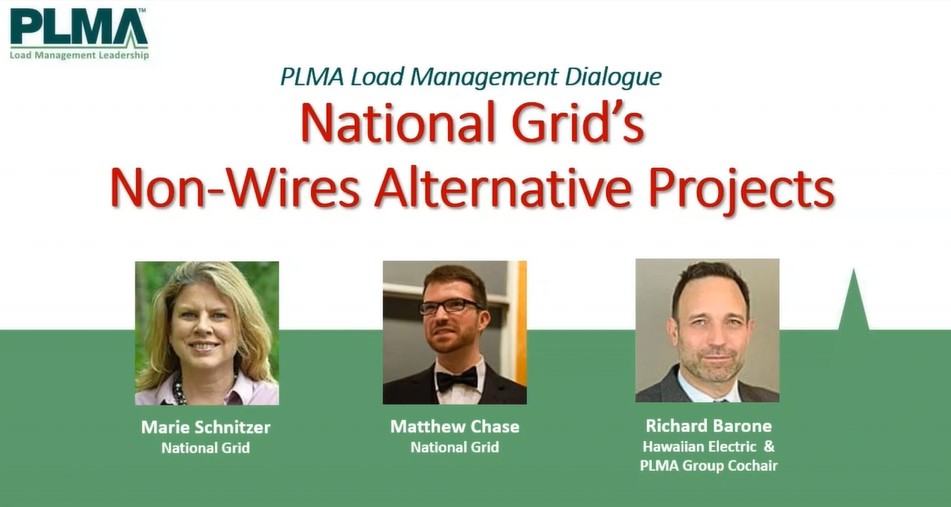 Discover key considerations from two leading non-wires-alternatives (NWA) projects. The Tiverton Project helped defer the need for traditional electric grid infrastructure upgrades. This discussion will share insight regarding customer-driven load curtailment program focused on automated demand response (DR) utilizing a wide variety of DR and energy efficiency resources. The Old Forge project is focused on solving distribution grid constraints and providing grid resilience solutions with a battery energy storage system. Discover key takeaways and lessons learned from these National Grid projects implemented in remote areas involving local communities and unique strategies to develop solutions. Discover key considerations from two leading non-wires-alternatives (NWA) projects. The Tiverton Project helped defer the need for traditional electric grid infrastructure upgrades. This discussion will share insight regarding customer-driven load curtailment program focused on automated demand response (DR) utilizing a wide variety of DR and energy efficiency resources. The Old Forge project is focused on solving distribution grid constraints and providing grid resilience solutions with a battery energy storage system. Discover key takeaways and lessons learned from these National Grid projects implemented in remote areas involving local communities and unique strategies to develop solutions.
Source: Load Management Dialogue with Marie Schnitzer and Matt Chase, National Grid; and Richard Brarone Hawaiian Electric
Type: Webinar
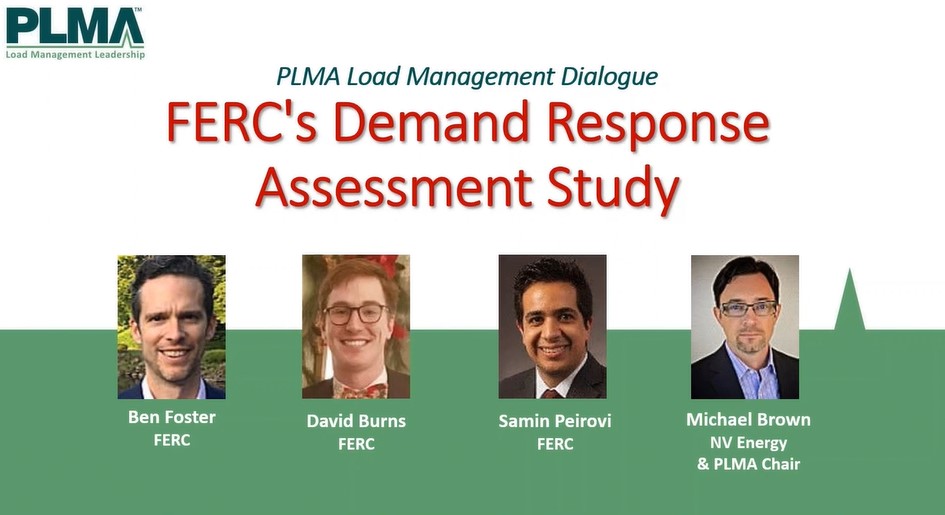 A discussion between a representative from the Federal Energy Regulatory Commission (FERC) and the PLMA Chair on FERC staff's recent update to its annual assessment study. This report is FERC staff's 13th annual report on demand response and advanced metering required by the Energy Policy Act of 2005. It is based on publicly-available information and discussions with market participants and industry experts. A discussion between a representative from the Federal Energy Regulatory Commission (FERC) and the PLMA Chair on FERC staff's recent update to its annual assessment study. This report is FERC staff's 13th annual report on demand response and advanced metering required by the Energy Policy Act of 2005. It is based on publicly-available information and discussions with market participants and industry experts.
Source: Load Management Dialogue with Ben Foster, David Burns, and Samin Peirovi, FERC; and Michael Brown, NV Energy
Type: Webinar
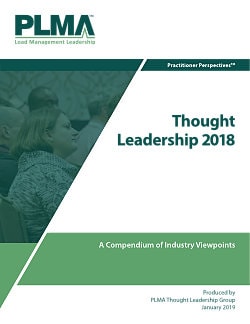
Transcripts from 8 selected webcasts and conference sessions produced by PLMA in 2018.
Source: PLMA Thought Leadership Group
Type: Compendium
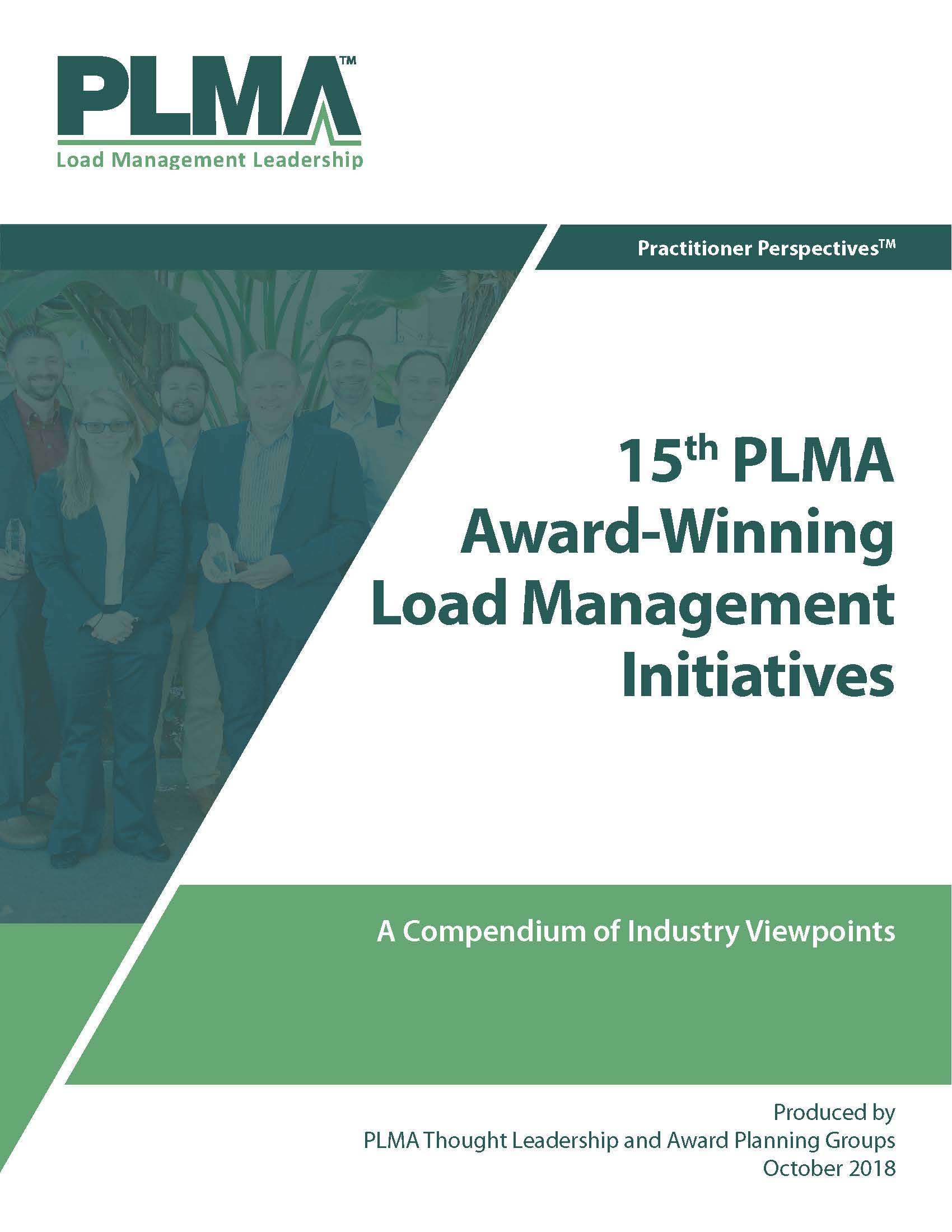
Six transcripts of webcast interviews with the 16th PLMA Award winners for best demand response and other load management programs, initiatives and achievements.
Source: PLMA Thought Leadership and Award Planning Groups
Type: Compendium
January 2019
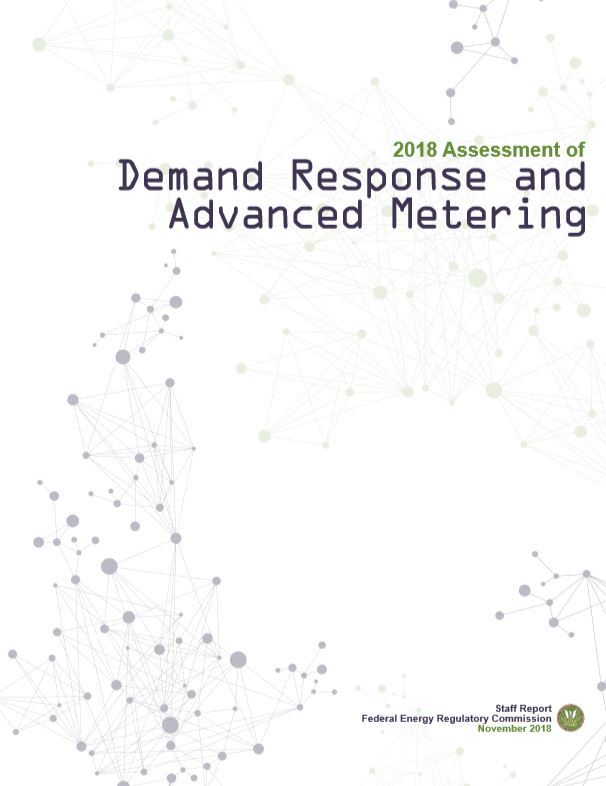 The Commission issued its 2018 Staff Assessment of Demand Response and Advanced Metering based on publicly available information from a variety of sources, as well as discussions with market participants and industry experts. This report is the Federal Energy Regulatory Commission staff’s (Commission staff’s) thirteenth annual report on demand response and advanced metering required by section 1252(e)(3) of the Energy Policy Act of 2005 (EPAct 2005). The information presented in the report is based on publicly-available data and discussions with industry experts. The Commission issued its 2018 Staff Assessment of Demand Response and Advanced Metering based on publicly available information from a variety of sources, as well as discussions with market participants and industry experts. This report is the Federal Energy Regulatory Commission staff’s (Commission staff’s) thirteenth annual report on demand response and advanced metering required by section 1252(e)(3) of the Energy Policy Act of 2005 (EPAct 2005). The information presented in the report is based on publicly-available data and discussions with industry experts.
Source: FERC
Type: Report
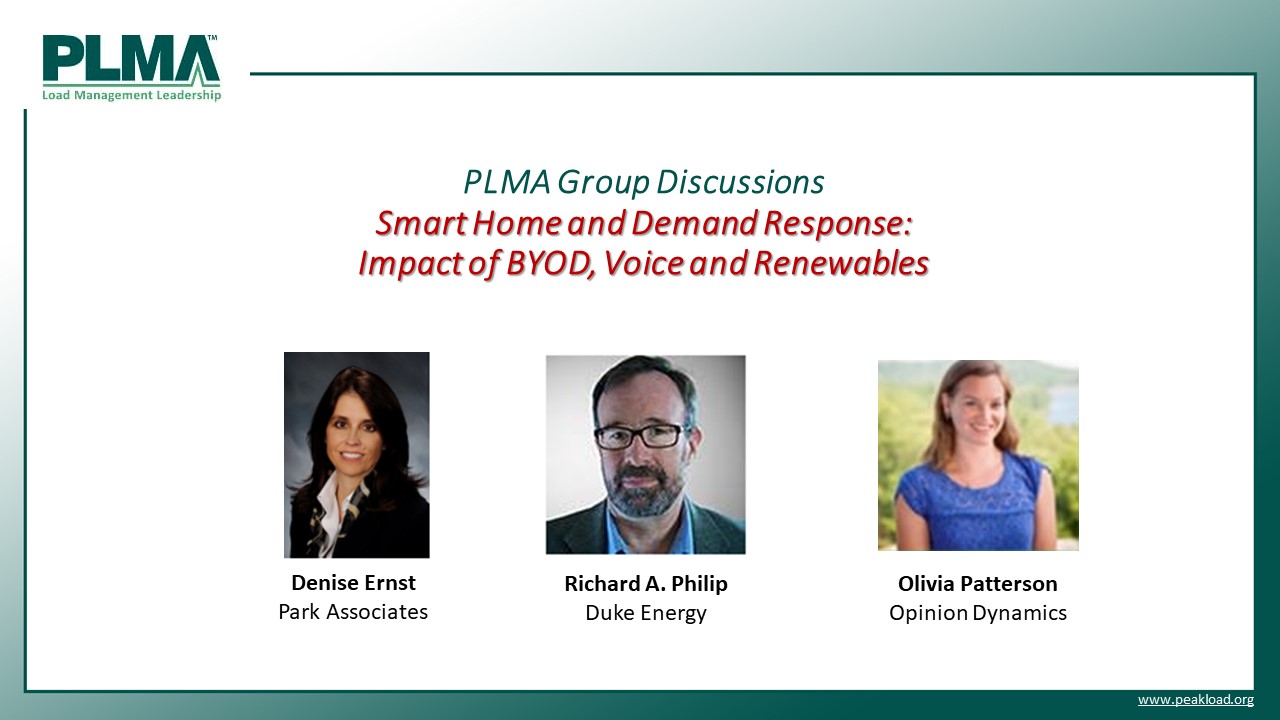 Learn about the impact of voice-enabled and other emerging technologies on BYOD and other dynamic load management programs being deployed by utilities and other energy services providers. Bring-your-own-device (BYOD) demand response programs are gaining momentum with utilities and consumer adoption of smart thermostats, solar panels, and battery storage is growing. This discussion with Parks Associates industry expert Denise Ernst and Rich Philip of Duke Energy features insight from the recent Consumer Electronics Show and Association of Heating & Refrigeration Expo into the impact of voice controls on the residential energy ecosystem, as well as new developments with net-zero energy homes and community solar. Learn about the impact of voice-enabled and other emerging technologies on BYOD and other dynamic load management programs being deployed by utilities and other energy services providers. Bring-your-own-device (BYOD) demand response programs are gaining momentum with utilities and consumer adoption of smart thermostats, solar panels, and battery storage is growing. This discussion with Parks Associates industry expert Denise Ernst and Rich Philip of Duke Energy features insight from the recent Consumer Electronics Show and Association of Heating & Refrigeration Expo into the impact of voice controls on the residential energy ecosystem, as well as new developments with net-zero energy homes and community solar.
Source: Load Management dialogue with Denise Ernst, Parks Associates; Richard Philip, Duke Energy and Olivia Patterson, Opinion Dynamics. Co-hosted by Smart Energy Summit.
Type: Webinar Recording
|








 Eversource Energy introduced an innovative holistic approach to reducing peak demand among commercial and industrial (C&I) customers. Their active-demand management demonstration utilized a wide range of technologies, including battery storage, ice storage, phase change material thermal storage, advanced software and controls and wi-fi thermostats, to engage large and small C&I customers. Not only did the demonstration successfully engage with a variety of C&I customers, it also reduced the 2018 regional peak by 8.7 MW. This demonstration project shows that taking a holistic approach to demand reduction is necessary for the long-term viability of demand-reduction programs and paved the way for the development of an approach to peak-demand management featuring various technology types, each using open communication protocols that connect to a single dispatch platform.
Eversource Energy introduced an innovative holistic approach to reducing peak demand among commercial and industrial (C&I) customers. Their active-demand management demonstration utilized a wide range of technologies, including battery storage, ice storage, phase change material thermal storage, advanced software and controls and wi-fi thermostats, to engage large and small C&I customers. Not only did the demonstration successfully engage with a variety of C&I customers, it also reduced the 2018 regional peak by 8.7 MW. This demonstration project shows that taking a holistic approach to demand reduction is necessary for the long-term viability of demand-reduction programs and paved the way for the development of an approach to peak-demand management featuring various technology types, each using open communication protocols that connect to a single dispatch platform.






















